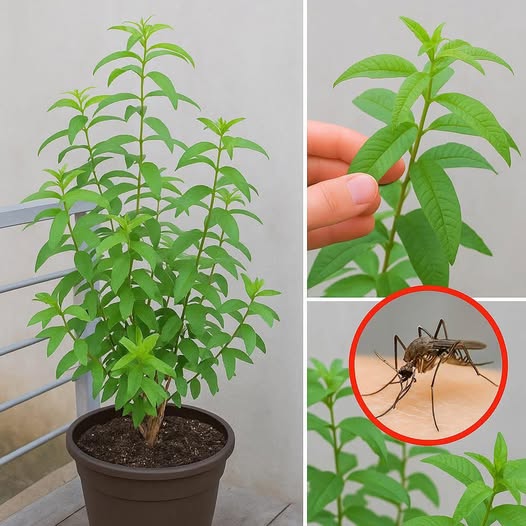Lantana: the flower that makes the garden colorful and keeps mosquitoes away!
Are you tired of scaring away mosquitoes with electric rackets, citronella candles and sprays that smell like a laboratory?
Well, there is a much simpler (and prettier) way to reduce the presence of these intruders: planting lantana .
Next, discover why this tropical species has become a favorite among gardeners, how to grow it without any mystery and where to position the pots to create a natural barrier against insects.
1. From buzz to solution – three quick notes
- Summer = mosquito season
High temperatures accelerate the life cycle of these insects, which bite more and reproduce in any forgotten puddle. - Chemical repellents are not always popular.
Strong aroma, high cost and risk of irritation in sensitive people encourage the search for green alternatives. - Lantana solves two problems at once
. Showy flowers brighten up the balcony; essential oils released by the leaves create an aromatic “force field” that disturbs mosquitoes’ sense of smell.2. Portrait of the star of the post
Feature Practical details Scientific name Lantana camara (Verbenaceae family) Origin Central and South America Port 50 cm to 1.5 m, herbaceous or shrubby Flowers Multicolored curls that change hue as they mature Foliage Dark green, slightly serrated edges, slightly citrusy aroma when kneaded Fruits Small black berries – decorative but not edible Resistance Tolerates strong sun, intense heat and short periods of drought
3. Why does lantana repel mosquitoes?
The plant synthesizes triterpenes, lantana and essential oils that serve as a natural defense against herbivores. For us, the scent is almost imperceptible; for Aedes aegypti , Culex and company, it is a means of escape. Field research shows a significant reduction in the mosquito population in areas decorated with lantana clumps compared to sections without the plant. The more vigorous the plant is, the greater the emission of these volatile substances.
4. Growing Checklist — From Zero to a Blooming Garden
Use the squares to organize yourself when setting up the flowerbed or choosing the pot.
-
- Substrate : slightly acidic mix (pH 6-6.5) with good drainage; organic compost + coarse sand works well.
- Pot : minimum 25 cm deep; generous hole in the bottom + layer of expanded clay or gravel.
- Sun exposure : 6 hours of full sun per day ensure continuous flowering.
- Watering : moderate; wait for the top of the substrate to dry out a little before watering again. Avoid allowing water to accumulate on the plate.
- Fertilization : biweekly, spring-summer, with NPK 10-10-10 or sifted homemade compost. Suspend in winter.
- Pruning : cut tips after each flowering to encourage lateral shoots; remove dead branches.
- Pest control : lantana itself keeps insects away, but mealybugs may appear; clean with a damp cloth and diluted mild soap.
- Propagation : cuttings of 10 cm semi-woody branches; plant in light substrate until rooted.
5. Planting step by step for beginners
- Prepare the container
Line the bottom of the pot with 2 cm of pebbles; cover with a bidim blanket to hold the substrate. - Mixing the soil
Combine three parts topsoil, one part sand and one part humus. Fill to within 3 cm of the rim. - Position the seedling
Center the lantana, accommodating the roots without bending them. Fill with substrate and press lightly. - First watering
Water until the water runs out of the drain. The plant will “sit” in the pot – top up with substrate if necessary. - Acclimatization
Leave in partial shade for three days; then expose to full sun for good.
6. How to turn lantana into a mosquito barrier
-
- Windows and doors
Place pots on outdoor windowsills or next to entrances to create an “aromatic corridor.” - Gourmet balcony
Combine three or four vases in a line – in addition to repelling, it becomes a colorful focal point in the decor.
- Windows and doors
- Pool area
Solid beds in the pool prevent mosquitoes from approaching the standing water at the edges. - Backyard with pets
Warning: leaves and fruits can be toxic if ingested in large quantities. Keep out of reach of curious dogs.7. Maintenance tricks that enhance the repellent effect
- Regular fertilization = more powerful aroma
Balanced nutrients stimulate the production of essential oils. - Clean leaves
Dust layer blocks stomata; spray with water in the morning to remove dirt. - Pruning old flowers
Renewing the canopy encourages continued flowering and the emission of fresh volatile compounds. - Combination with other species
Combine lemon basil, rosemary or citronella to form a multifunctional repellent combo.
8. Keeping an eye on biodiversity
Although it keeps mosquitoes away, lantana attracts butterflies and bees thanks to its abundant nectar. This way, you control unwanted visitors without sacrificing pollinators – a double win for those who grow vegetables or fruit.
Conclusion
Planting lantana is one of the simplest, cheapest and most sustainable ways to reduce mosquito infestations during the summer.
The species requires little care, tolerates strong sunlight and rewards the gardener with a permanent show of colors.
By placing pots in strategic points around the house, you create a living barrier that eliminates the need for harsh chemicals, protects your family and also beautifies the environment.
Adopt lantana, try the tips in this guide and enjoy more peaceful nights – without ringing in your ears.
- Regular fertilization = more powerful aroma
-



